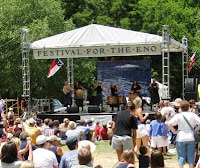Hello!
I would have posted earlier, but as you know...I'm on turtle time!
As an Eastern Box Turtle, it was easy for me to stow away in a suitcase by tucking in my head and legs. Samsonite has nothing on a turtle's trusty shell! Before you could say "Turtles are truly terrific," my friend Sheila toted me to sunny California.
While here, I'm busy having fun in the sun while promoting this year's exciting 2011 NAAEE Conference in Raleigh, NC and checking out the state that will host the NAAEE Conference in 2012. Take it from this terrapin, you'll want to travel to both these destinations for the best professional development in EE!
Here I am posing with Jenny Rigby outside Acorn Naturalists--the science and nature supply company that's well-known by environmental educators the world over!
Jenny treated me to a grand tour of her eco-friendly American Craftsman bungalow in Old Town Tustin, CA. We entered through handcrafted doors featuring a beautiful oak tree. It reminded me of the shimmering oak tree on the Raleigh Convention Center! Whether doing EE out west or back east, we are all "Rooted in Time, Branching to the Future."
Inside we saw all the cool books, activity guides, and field equipment that fill the pages of the Acorn Naturalists catalog. Plus, lots of turtle-themed and nature inspired gifts which are perfect for this, the Year of the Turtle!
Be sure to visit the Exhibit Hall at Raleigh's 2011 NAAEE Conference to meet all kinds of companies and organizations that sell educational materials to support quality EE!
Next, this landlubber lumbered further up the beach where I met another new friend. Riley was visiting the beach from the desert region of Phoenix, AZ. She invited me to join her and her siblings in sculpturing sandcastles and excavating moats before high tide would sweep them away. What fun!
These youngsters were very curious about turtles--both those that live on land and those who make the ocean their home. I told them how we turtles like to dig our nests and lay our eggs in sand and soil. I also gave them ideas on how they could help turtles everywhere. Environmental educators who come to the 2011 NAAEE Conference will hear Jean Beasley speak on how she founded the Karen Beasley Sea Turtle Rescue and Rehabilitation Center on Topsail Island, NC to help sea turtles in trouble. I'm looking forward to seeing Jean's education assistant Lennie, a blind Kemp's Ridley sea turtle who is my BTF (best turtle friend!)
Goodbye! It's time for ol' Tryon T. Turtle to trek back to NC to promote the 2011 NAAEE Conference. I've got to let everyone know that the early bird registration deadline is coming up August 11th! You remember the story of the Tortoise and the Hare? Be quick and register by clicking on "Conference" atwww.naaee.org. Hope to see you there!




















